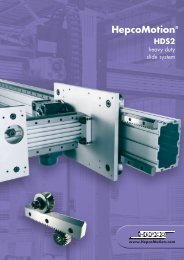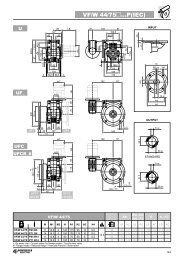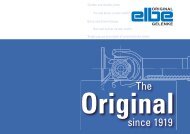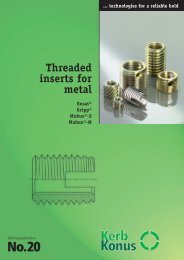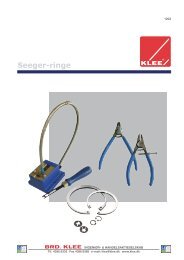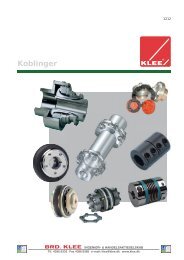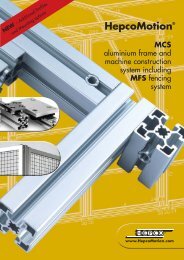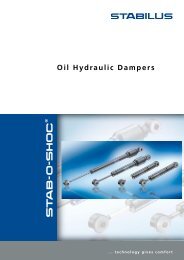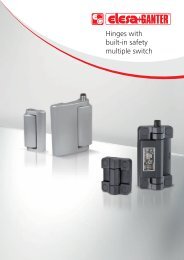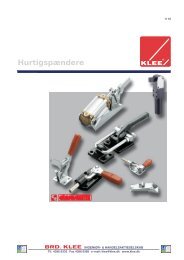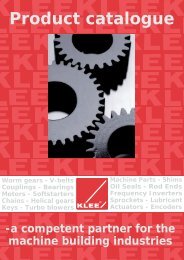LINEAR MOTION SOLUTIONS - Brd. Klee A/S
LINEAR MOTION SOLUTIONS - Brd. Klee A/S
LINEAR MOTION SOLUTIONS - Brd. Klee A/S
You also want an ePaper? Increase the reach of your titles
YUMPU automatically turns print PDFs into web optimized ePapers that Google loves.
Clearance & Mounting<br />
Linear Ball Bearings<br />
CLEARANCE & FIT<br />
Standard-type Simplicity ® linear ball bearings matched to a<br />
shaft that provides inadequate clearance may result in early<br />
bearing failure and/or rough linear motion. The clearance<br />
adjustable linear ball bearings and open linear ball bearings<br />
can be adjusted when assembled in the housing by controlling<br />
the housing bore. However, too much clearance will increase<br />
the deformation of the linear ball bearing, which will affect<br />
its precision and life. Therefore, the appropriate clearance<br />
between the ball bearing and shaft, and the appropriate linear<br />
ball bearing housing bore are required based on application.<br />
Table 2 shows recommended fit of the linear ball bearing:<br />
TABLE 2<br />
SHAFT & HOUSING<br />
To optimize performance of the Simplicity ® linear ball bearing<br />
it is recommended that a high precision shaft and pillow block<br />
are required.<br />
Shaft<br />
The rolling balls in the Simplicity ® linear ball bearing are<br />
in line contact with the shaft surface. Therefore, the shaft<br />
dimensions, tolerance, surface finish, and hardness greatly<br />
affect the performance of the linear ball bearing. The shaft<br />
should be manufactured to the following tolerances:<br />
1) Surface finish critically affects the smooth rolling of balls;<br />
Shaft surface finish should be 6-8 micro (RA# 7.2 to 10.8 a<br />
1.11 to 1 ratio).<br />
2) Shaft hardness should be HRC 60 to 64. Hardness less<br />
than HRC 60 will decreases the life/load, see page 126.<br />
3) Preload increases the frictional resistance slightly, If the<br />
preload is too tight, the deformation of the bearing sleeve<br />
will shorten the linear ball bearing’s life.<br />
Housing<br />
There are a wide variety of housings differing in design,<br />
machining, and mounting. See Table 2 (above) and the<br />
following section on mounting requirements.<br />
Technical Information<br />
MOUNTING<br />
When inserting the linear ball bearing into the housing, do not<br />
hit the linear ball bearing on the end-retaining ring, but apply<br />
pressure either by hand or arbor on the linear ball bearing<br />
sleeve (See Fig.1) To insert the shaft into the mounted linear<br />
ball bearing, make sure the shaft is chamfered and be careful<br />
not to push on the balls by inserting the shaft at an angle.<br />
NOTE: If two shafts are used in parallel, the parallelism is an<br />
important factor to assure smooth linear movement and not<br />
damage the linear ball bearings.<br />
Examples of Mounting<br />
The popular way to mount linear ball bearings is with a<br />
slight preload. PBC Linear recommends a slight clearance<br />
fit-up to ensure proper life. The examples, Figs. 2 to 6, show<br />
the inserted linear ball bearing using a variety of retention<br />
methods.<br />
FIG. 1 FIG. 2 FIG. 3 FIG. 4 FIG. 5 FIG.6<br />
124<br />
800.962.8979 • www.pbclinear.com



